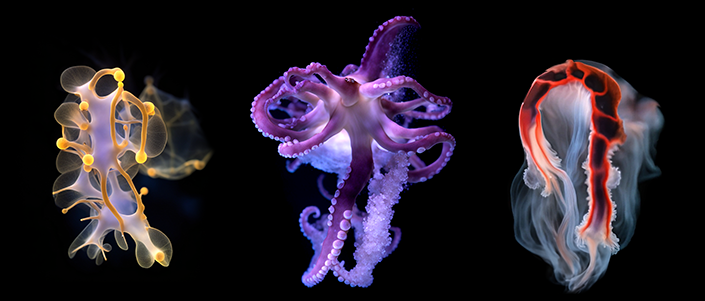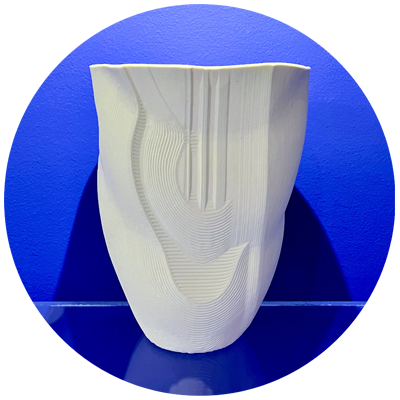Cross-campus Exhibit Bridges Art and Science
Story by:
Published Date
Story by:
Topics covered:
Share This:
Article Content
It only happens every five years and has been dubbed the “Olympics for art in Southern California.” This fall UC San Diego is among 70 institutions taking part in a five-month-long regional exploration of the intersections between art and science, led by Getty, an LA-based arts organization committed to exhibiting, conserving and understanding the world’s artistic and cultural heritage. The sprawling art event—called “PST ART: Art & Science Collide”—extends from Los Angeles to San Diego and Palm Springs.
Two major exhibitions, developed over four years with support from Getty, will premiere at the university. “Embodied Pacific” is a project led by the Department of Visual Arts with Birch Aquarium at Scripps Institution of Oceanography. The exhibition, curated by art and science historian Lisa Cartwright and cognitive scientist Nan Renner, features work created by artists in collaboration with scientists from Scripps Oceanography and Indigenous community leaders in environmental and ocean science, engineering, art and design.
A second PST ART exhibition, “Helen and Newton Harrison: California Work,” will be on view at the Mandeville Art Gallery. Curated by Visual Arts Ph.D. alum Tatiana Sizonenko and Heath Fox working with Mandeville Art Gallery Director Ceci Moss, this is one of four exhibitions about the Harrisons—who were founding members of the Department of Visual Arts and advanced environmental art and science collaboration at UC San Diego from the campus's earliest years.
“UC San Diego is a place where the arts, sciences and technology intersect through immersive performances and inspiring exhibitions,” said Dean of the School of Arts and Humanities Cristina Della Coletta. “Our university, which has a thriving arts ecosystem supported by the Chancellor’s Arts Initiative, is an ideal site to spur dialogue on urgent issues of our time through the expansive PST ART program.”
Exhibitions at UC San Diego and local partner institutions open between Sept. 12 and Oct. 4. Plan your visit by learning more about each below.

‘Embodied Pacific': An intercultural approach to sustaining our oceans
A PST ART: Art and Science Collide partnership between UC San Diego Visual Arts and Birch Aquarium at Scripps Institution of Oceanography, EMBODIED PACIFIC is an intercultural platform of exhibitions, workshops and programs devoted to exploring the art and science of oceanographic and Indigenous maritime design and engineering through work by 30 artists working with researchers and knowledge keepers in laboratories, field sites and archives in Southern California and the Pacific Islands. Embodied Pacific's organizers invite immersive engagement in the art of oceanography, Indigenous design and critical craft at six venues throughout campus and in the San Diego community.
Presented by UC San Diego’s Department of Visual Arts and Birch Aquarium at Scripps Institution of Oceanography, visitors are invited to explore projects by 30 artists created in partnership with scientists and local Indigenous communities. The project is curated by Professor of Visual Arts Lisa Cartwright with Birch Aquarium’s Senior Director of Strategic Partnerships Nan Renner and Director of Exhibits Megan Dickerson.
Exhibitions, workshops and programs will be held at six venues:
Embodied Pacific: Ocean Unseen
Birch Aquarium at Scripps | Opens Oct. 4
“Embodied Pacific: Ocean Unseen” invites you to explore Scripps Institution of Oceanography and Indigenous science through the eyes of contemporary artists. These installations offer guests the chance to engage in scientific exploration through immersive, interactive experiences. Collectively, the exhibition asks us to consider how ocean science technology is not just about “high-tech” but also very much about the tools we use to shape our understanding of the ocean’s unseen mysteries. Eighteen artists across 10 projects come together in one immersive exhibition.
Embodied Pacific: Three Lives
The Gallery at Geisel Library | Opens Sept. 23
Gallery QI | Opens Sept. 26
Inspired by writer Gertrude Stein’s modernist trilogy “Three Lives” (1909) and Professor of Visual Arts Amy Adler’s “A Woman of No Importance” (2002), the works in this exhibition approach the subjugated histories of three groundbreaking oceanographers: Easter Ellen Cupp, Anita Smith Hall and June Pattullo—women who would have remained unseen in the history of oceanography but for a handful of archival materials held by family members and the Scripps Institution of Oceanography Archives, part of UC San Diego Library’s Special Collections & Archives.
Embodied Pacific: Seaways
Visual Arts Gallery at SME | Opens Sept 27
“Navigating Seaways” focuses on the art and science of Indigenous canoe-making and navigation methods. Long a symbol and tool of survival and sovereignty, the canoe is a vessel through which tradition, identity and sustenance have been navigated for millennia. Visitors can explore the design and impact of “ha kwaiyo” (tule canoes) made from bundles of tule reeds gathered from the shores of inland lakes and rivers that were used for fishing and transportation on Southern California waterways.

Embodied Pacific: Through a Porcelain Cast
The Nest at Geisel Library | Opens Sept. 12
An artist, working with ocean scientists, creates works inspired by the Zooglider, an autonomous vehicle that carries oceanographic sensors onboard and can sink to a depth of ~ 400 meters where it collects biological samples. These findings have been rendered into sounds and images of zooplankton, which are made tangible in a porcelain cast. The resulting porcelain dinnerware invites contemplation about our food chain and the possibilities for tactile engagement with scientific data.
“Embodied Pacific” off-campus sites include the Kosay Kumeyaay Market in Old Town and the Kendall-Frost Marsh Reserve at Mission Bay. At Kosay, an augmented reality installation by Kumeyaay artist Gloria Montes Crosthwaite and the Indigenous technology collective Our Worlds presents the botany and design of Kumeyaay basketry with traditional weaving and pottery of Indigenous artists of the region. The works are presented by artist and community leader Ana Gloria Rodriguez, Kosay's director, representative of the Kumeyaay Nation to Mexico, and founder of Tipey Joa Native Warriors. Titled “Weshow” (to weave a basket), this installation opens Sept. 27.
The Kendall-Frost Marsh Reserve at Mission Bay is the site of “Mural-Canoe,” an outdoor display featuring seven canoes by Sakman Mario Borja and the UC San Diego Speculative Design Major Class of 2023, fabricated from the upcycled panels of the historic Kendall-Frost trailer mural by artist Celeste Byers. The Reserve will also be the site of a new mural designed and produced later this fall by Visual Arts alum Oscar Magallanes and the 3B Collective in collaboration with Gloria Crosthwaite.

‘Helen and Newton Harrison: California Work’: Pioneers of ecological art
The expansive PST ART regional series also includes a multi-site exhibition of the work of pioneering ecological artists Helen Mayer and Newton Harrison. The dynamic husband-and-wife team joined UC San Diego in 1967—Newton as one of the founding faculty members in the Department of Visual Arts and Helen as director of Educational Programs at UC San Diego Extension (now known as Extended Studies).
The Harrisons resided in San Diego for nearly four decades, where they developed their original concepts of ecological art. They collaborated with biologists, ecologists, architects, urban planners and other artists to spark dialogue and uncover ideas to support biodiversity and community development. Responding to growing environmental awareness, the Harrisons pushed conceptual art in new directions, from their efforts to make topsoil—endangered in many places—to their transformation of a Pasadena debris basin into a recreational area.
This fall, the exhibition “Helen and Newton Harrison: California Work” will present nearly 20 projects produced between the late 1960s to the 2000s—the first exhibition to focus on their work in California. Curated by UC San Diego Department of Visual Arts alumna Tatiana Sizonenko, Ph.D. ’13, the show spans four sites across San Diego, including the La Jolla Historical Society (primary organizer), the university’s Mandeville Art Gallery, California Center for the Arts Escondido and San Diego Central Library Art Gallery.
Mandeville Art Gallery will present “Future Gardens,” which speaks to the Harrisons’ hope of saving the planet in the face of the crisis posed by climate change and its threat to Earth’s many ecosystems. Audiences will enjoy original drawings, phototext panels, photographs and conceptual design proposals. “Future Gardens” will reveal the Harrisons’ concept of Force Majeure and their adaptive responses to the pressure on planetary systems that are negatively impacted by industrial processes as global warming accelerates.
“Future Gardens” will open at Mandeville Art Gallery on Sept. 28 with a free opening reception from 2-6 p.m. Additional public programs will be held, including a keynote talk on “Thinking with the Harrisons: Re-imagining the Arts in the Global Environment Crisis” on Nov. 19 and a panel discussion on “Future Gardens as Eco-Cultural Collaborations” on Nov. 23.
You May Also Like
Stay in the Know
Keep up with all the latest from UC San Diego. Subscribe to the newsletter today.




